Last day of joint working -
Michael drives RF433 with his clippie, wife June, standing beside
him.
Photo © Jim Blake
For Pat Spencer's memories, see the foot of the
236 page.
The late Michael
Parsons (seen here in 2009) told us his
story:
My memory goes back to about 1945-46, when my father and I were
on a 623 trolleybus going up Forest Road towards
Walthamstow. I noticed what I now know to be red
2RT2 buses parked up on some land outside the Eveready
Works. I did ask father why they were there, but he did
not know - I found out in later life that it was due to problems
with the brakes.
Leyton Bakers Arms, just up the road
from Leyton Garage where Michael worked. H1-class trolleybus
899 is working the 557, one of the routes travelled by the young
Michael. For more east London trolleybuses, see
here.
Photo © David Bradley
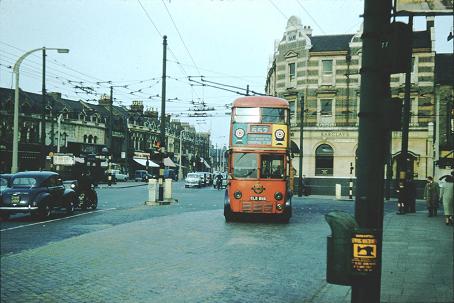 When I was about twelve, on Sunday
afternoons after I had done the dinner-time washing up I was sent
out to get some fresh air. I took to going for a ride on the
local bus routes, 35, 35A, 38, 38A, 20, 144
and of course the trolleybuses 557, 661 and 623. On one
occasion, I got on a 38A up to Loughton Stn; at
that time there was a large road builders by the name of W
& C French at Buckhurst Hill, I found the yard and to my
delight there was line of six ex-LT STLs all in red with the
LT logo painted out. I used to get a 661 to the Green
Man and a 20 to Epping Town and walk down to North Weald Airfield
and watch the Meteor and Vampire jets take off and land; we used to
be able to catch lizards, newts and sticklebacks in Epping
Forest in them days.
When I was about twelve, on Sunday
afternoons after I had done the dinner-time washing up I was sent
out to get some fresh air. I took to going for a ride on the
local bus routes, 35, 35A, 38, 38A, 20, 144
and of course the trolleybuses 557, 661 and 623. On one
occasion, I got on a 38A up to Loughton Stn; at
that time there was a large road builders by the name of W
& C French at Buckhurst Hill, I found the yard and to my
delight there was line of six ex-LT STLs all in red with the
LT logo painted out. I used to get a 661 to the Green
Man and a 20 to Epping Town and walk down to North Weald Airfield
and watch the Meteor and Vampire jets take off and land; we used to
be able to catch lizards, newts and sticklebacks in Epping
Forest in them days.
When I left school in 1954, I started work as the gofer and tea boy
on the maintenance staff at a suitcase manufacturer called S
Noton Ltd at the back of the Eveready Works. All this site
was the old AEC works of the old General Buses where the B-types
were built. Our job took us all over the complex; one part
was an old cellar that had been disused for very many years.
There were no lights and when we did eventually get some jury
lights, we found about a dozen or so very rusty primitive petrol
engines; we thought that these had been meant for the B-types and
as far I know they were still there in 1957. I also
watched them dig up the old AEC railway sidings to start building
on to the factory.
I left there in late 1957 and got onto the Eastern National as a
conductor out of Wood Green Depot on the main road (251) from Wood
Green to Southend; my mates were earning £12 a week and all I
could earn was £5 a week and I wanted a car and girlfriends!
I was put with an old guy by the name of Bill Eves, one week we
were doing the last one home from Southend (2125) and all week we
should been running behind a swinger as far as Romford
Market. The swinger was an extra that should have been in
front by three minutes to pick up all the short rabbits,
leaving us to pick up the long runners, all week we had gone
round him and took the road then we never saw him again. On
the last Saturday of the job, old Bill told me to get him going
with the bell out of Southend, we went like mad down the
Southend road into Raleigh where we left the stand by now about ten
minutes early, turned left past the station down the hill and into
the speedway stadium car park. All the lights went out, I
told our rabbits what was going on, and within ten minutes or so
our swinger went past with a domino load. We pulled
out and sat behind him all the way to Romford; he got
slaughtered but never pulled that trick again. [See
here for
more on Mick's days as a conductor with EN, courtesy Essex Bus Enthusiasts Group]
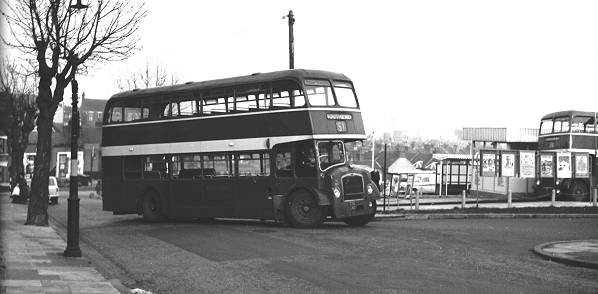 Eastern National 1958 experimental Bristol LDL 236LNO,
driven by Michael, seen arriving at Southend in 1965 on his route
251.
Eastern National 1958 experimental Bristol LDL 236LNO,
driven by Michael, seen arriving at Southend in 1965 on his route
251.
Photo © SCT61, follow link for
more details
Then in 1961 I passed my PSV test around the West End
of London on a Leyland PD2. I was taught bus work by an old
City driver who was seventy when I first started and he knew
every trick in the book - in fact he used to make me cringe at
times, but no one ever tried to outdo him and if they did they
never did it a second time. One of the buses I conducted then
drove was a brand new Bristol LDL Lodekka, bonnet number 1541,
registration 236 LNO, which was one of the first 30ft seventy
seat buses ever built. After a long working life she is
now preserved and appeared at Duxford for the first time in
2008.
Once in Raleigh High St, it was on the journey home, I had
pulled into the stand and picked up a load of wombles (old people)
in the forward entrance FLF. I got the bell, slipped into
gear (crash box with overdrive out of top - 6th was out of
5th - so do not stop in top), eased out of the stand,
turned left down the hill and within a few yards got loads of
bells. I pulled over got out and went round to find out what
was amiss, went into the bus and there is a woman at the back
of the bus covered in white, as was the back of the bus - it turns
out she had got on carrying a cream cake in her arms and as I had
turned left she got into a trot and hit the back of the bus,
the cake exploded and went in all directions, all the wombles
were in tears with laughter, as I soon was. She was not hurt and
saw the funny side of it all, we never heard any thing more about
it; we worked the bus through to Brentwood and got it changed,
people were laughing for a long time about that. [See
here for
more on Mick's days as a driver with EN]
I left the National in about 1962 as I wanted to go long
distance HGV driving. I ran for Harry Lebus out of Tottenham
and I used to do Aberdeen, Inverness and up to Wick and
Thurso. That lasted until 1969 when I went up to Manor House
[London Transport Recruitment Centre] as by this time I was married
and my late wife June was nagging me about being away too
long.
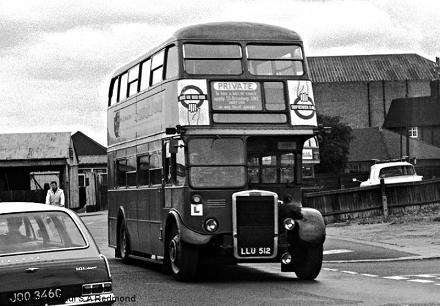
RTW362 nears the end of its
life with LT, in use as a trainer. It was based at both Grays
and Edgware between 1965 and 1970 - thanks to Andrew
Chilcott for spotting that the Vauxhall was registered in
Essex during 1965, so this is most likely Grays.
Photo © Paul Redmond
I got in, spent two weeks at Chiswick and although I already had
my PSV, the Board told me that I must go through the training
school so I had a week in the classroom and a week on the road in
an RTW and the skid patch. When I took my LT test in an RTW
(no power steering and they were heavy) around the West End, the
examiner placed a cup of water on the floor of the bus and
told all three of us if we managed to spill the water from the
cup he would drop us - so that would mean starting again and none
of us wanted that to happen, apart from the embarrassment of
failing the test, so we did not spill the water and we
passed.
That was on the Friday morning then I did type training the
afternoon on RT, RM, RML, RF and a quick one in an MB. I
started at Leyton Shed (T) on the Monday morning and was sent out
route learning. I passed all my route learning on all
the routes - 38s, 48s, 69s, 262s and of course the 236/210s. You got
the conductor to sign the learning sheet to say that you had done
the route which was then handed into the office.
By this time June had decided that she wanted to get onto LT and
hopefully become my clippie. I was spare to start with, doing
all routes and even some of West Ham's and Walthamstow's.
June went and did her training week at Chiswick and she
joined me at Leyton although not on the same shift times.
Then we started to try to get onto the same rota line which took a
few months but we did eventually.
Being spare I was put onto the 38 road at different times, on
late or early with a new conductor each day. The 38 road was
a fast hardworking road with RTs, with something like a three
minute headway from Walthamstow Garage to Victoria through
Oxford Street, Piccadilly Circus and Hyde Park Corner, so if you
did not keep your foot down the guy behind you was punching you up; some would work the road with
you taking one stop for one stop, some would not, but more often
than not a couple of you would work the road together.
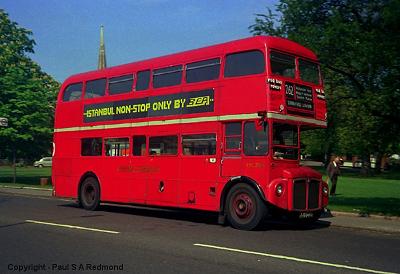 June arrived at Leyton and went on the spare, doing as
I was doing. At the next rota change, I was put on my own
rota line on the 262/69 road, which ran the RML type, with a huge
overweight conductor whose name that I cannot remember.
All he wanted to do was sit on the back seat and reach round
to ring the bell and did not like me to go round another bus
to share the road. In my world he was lazy, so I nicknamed
him Pig Features.
June arrived at Leyton and went on the spare, doing as
I was doing. At the next rota change, I was put on my own
rota line on the 262/69 road, which ran the RML type, with a huge
overweight conductor whose name that I cannot remember.
All he wanted to do was sit on the back seat and reach round
to ring the bell and did not like me to go round another bus
to share the road. In my world he was lazy, so I nicknamed
him Pig Features.
By this time June had got herself onto the rota on
the 262/69 road and we set about asking Pig Features to swap
with her. He did not want to know, so I decided to make him
work - and he did, by most of the time having a full load. He
used to complain to me as to how tired that he was, but I told him
that was the nature of the beast.
Leyton's RML2366 working route 262.
Photo © Paul Redmond
Our luck changed when June's driver left, so I got a rota change
onto her line. Bearing in mind that LT was short of platform
staff at this time, we worked a rest day every week as a crew and
did earn good money between us. On one occasion we were
on an early turn on the 38s, waiting to leave Victoria, where a
jumper (Inspector) was always on duty on
the stand in rush hours to get you out on time and fill up the
bus with wombles going up to Hyde Park etc. He thought that
June was on the top deck collecting fares and gave me two bells;
but she was answering a call of nature which I did not know
about; I was away, first stop Hyde Park Corner then I sat
there waiting for the bell. I finally got out to find out
what was going on and the wombles told me that I had left her at
Victoria, so then I had to wait for the following service to catch
up and we both worked the road home. Nothing was said and the
jumper said ‘sorry’ the following morning, so a lot of wombles got
a free ride to work.
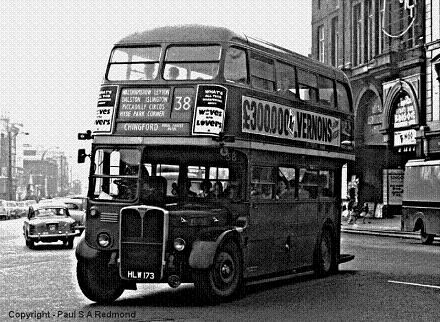
Leyton's RT186, carrying a
much later body than its registration would suggest, runs the 38
and leans taking a junction on its way to Chingford.
Thanks to Roy Barnacle for identifying the
junction as Islington Green.
Photo © Paul Redmond
On another occasion, on the 38s again, we were on a very late
one on our way home on a Saturday night. I pulled up at
the stop at Piccadilly and a crowd just out of the theatres got
on. One guy would not go either up or in but stood on the
platform trying to stop himself being sick (too much to drink)
and June came round to me at the next stop to tell me what this guy
was doing. We were finishing, all the punters on the long
seats were cringing away from him, so I pushed it hard up
round the bend in New Oxford Street and he sort of fell off onto
the footpath and by all accounts the punters cheered, so pleased
that he had not done anything over them; we just carried on
home.
Once when we were on the 48s (RMLs), a woman got on in Dalston
Lane with a pushchair and just left it on the platform. June
was on the top deck; she gave me the bell, off I went and as I took
the right hand bend at the top of Dalston Lane I got lots of
bells. I stopped, got out and went round to see the pushchair
vanishing down Ridley Road and the woman chasing after it, we just
carried on as she had not paid her fare and I was blocking the
road. Late one night in the week, we were on the 55s (RTs)
and we used to turn in Walthamstow Garage. When we got there,
the yard was full with buses - I should have put out the lights and
gone round to the Crooked Billet doughnut to turn but we wanted a
cup of tea, so I foolishly turned into Walthamstow’s yard, at
the entrance there was an LT roundel on a high post in my struggle
to turn around I managed to put one of the arms of the
roundel through a top deck window breaking it. When we
got back to Leyton and did an occurrence report we said that some
kids were throwing stones in Hoe Street and that's how the window
was broken. Exploits of a typical LT crew – it’s too late now
for me to be booked by a jumper and appear before the garage
manager now, although I must say it only happened a couple of times
usually for running early.
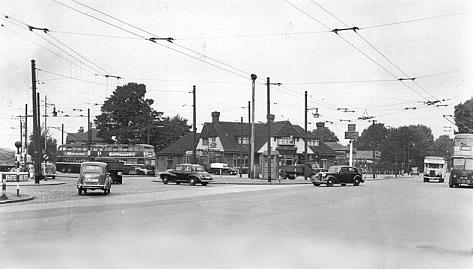
The Crooked Billet 'doughnut' in the 1950s,
well before route 55 was introduced and when the only motorbus
route past Walthamstow Garage was the 38.
Photo © David Bradley
In my time on LT I only had one accident and a
coroner's jury cleared me of any blame. I was on the 55s
working back to Leyton Green for my meal relief on a Saturday
afternoon, which by this time was OMO with the DMS type. I
had picked up a domino load out of the Narrow Way shopping
centre in Hackney: women, kids, husbands young and old and
loads of bags. As I approached the white stop opposite
Clapton Pond a guy staggered into the road. I sat on the horn
but no response. he kept on coming. I swung the wheel to the
right and I found myself looking at a 106 (RM) at the
stop on the opposite side of the road and I can still see
the driver’s eyes staring at me; I do remember thinking me and
him will finish up in the same cab and my wombles and his wombles
will get badly hurt if I carry on this path, so
I swung the wheel back to the left, another foot and
I would missed this guy but I did not.
His head hit the nearside pillar then he was gone.
I came to a stop round the back of the bus stop; as luck
would have it, there was a wide pavement behind the bus stop and
nobody was on it. By this time everybody was screaming I
isolated the doors and asked for three witnesses, which
I quickly got, then let the passengers out. I did look
through the back window and he was lying in the road with people
around him. I did not get off as I had my takings in my cab,
the police arrived and an ambulance which took him away, the
police told me that he reeked of drink. A jumper arrived and
I gave all the statements to him and the police. He asked me
if I was ok to drive, I said yes, so I got the bus out from
behind the bus stop and ran it back dead. I had a late
meal break and went out and finished what was left of my
second half (no health and safety in them days). He passed
away that evening with serious head trauma; the case eventually
came to the coroner's court in Hackney Town Hall, I gave my
evidence and I was cleared of any blame - it was decided that he
was drunk and it was his own fault. The following day (Sunday)
I was on the same times and road and a woman got on in Hackney
Mare Street. As she gave me her fare, she spoke about the
accident the previous day saying everybody on the bus was amazed
that no one on the bus had been hurt, not knowing that it was
myself at the wheel. I then felt a little bit better about it
all although I did not have a lot of sympathy for the guy - his
actions could have hurt a lot of people.
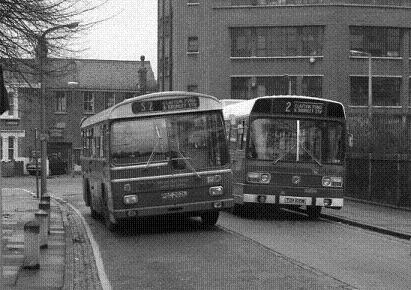
Clapton Pond, and MS2 passes
LS6, both buses of the trial batches tested on the S2 (formerly the
208).
Photo © John Law
Thinking of Clapton Pond, I did watch as Scania MS4 on its
first day out on the S2s drove straight into Clapton Pond
- all the way in.
The 236 road was a very friendly road and we got to know most of
the punters by name, it was a road that seemed to be little known
unless you lived on the route that it covered. June and I
shared the 236/210 road with turns on the 55s and 69s, at that time
Leyton shared the road with Dalston (D) and quite often did
shorts and turned in Dalston Shed. We could always get a cup
of tea in Dalston's canteen, more so on late turns.
We would do the short at the start of our turn from Leyton
Shed via Leytonstone Station to Dalston Shed then back to
Leytonstone Station and take up the service to Stroud Green.
If we started on an early turn, we took the bus (or, to use an
old Eastern National term, tram) out of Leyton Shed and ran via
Leytonstone on to Finsbury Park Station then back to
Leytonstone. Sometimes it was a long first half with two
rounders, or it could be a short first half with just one rounder
before running back to Leyton Shed for our meal break which
was anything in between 3/4 of an hour to an hour and a
half. For the late turns, on early afternoons we would jump
on a 235 (OMO) outside the shed to go round to Leytonstone
Station, to take over on the stand, again a nice cup of tea in
the station canteen. Late afternoon or evenings
starts, we would take our tram out of the shed. On a couple
of occasions if we came out of the shed late (NBA` - no bus
available) in the afternoon, we would run straight down Leyton High
Road and turn right at Leyton Town Hall and June would make
her waybill up as though we had gone the correct road.
The busiest times were the rush hour morning and evening
plus when the Arsenal Football club played at home
either on Saturday afternoon or a late evening match, as we
passed within a few yards of their ground. Then we would get
slaughtered with a domino load of supporters and every stop on the
way home - if the Arsenal had won they were in good sprits, but if
they lost you could see it in their faces and they were not happy
wombles.
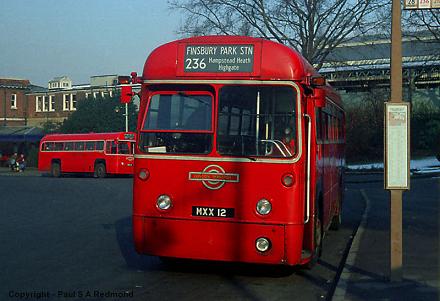 RF370 sits at Golders Green on a Sunday between 1968
and 1970, during the period when the route replaced the 210 on that
day.
RF370 sits at Golders Green on a Sunday between 1968
and 1970, during the period when the route replaced the 210 on that
day.
Photo © Paul Redmond
Sunday was a nice day to do the 210s, the day’s work was only
two rounders, Leytonstone Station to Golders Green
Station, with a cup of tea at Golders Green and our meal
relief at Leytonstone Station. It made a pleasant day to go
over Hampstead Heath and past Jack Straws Castle, with all the
families going out for the day and to see the kids go fishing in
the pond.
We had eleven RFs, including numbers 335, 410, 416, 433, 435,
447, 451, 467, 469, 494 and 501. Dalston had nine RFs
including numbers 373, 394, 395, 405, 413, 446, 474 and
484 for the service, the last crew RFs in LT service.
RF447 was a slow motor, it just would not go, but RF469 was a flyer
and it did go well.
As we very rarely saw a jumper on the road, we did at times pull
a few strokes. On one occasion, we went through Ridley Road
street market, which was busy on a Saturday, late on a
Saturday night a guy was stood at the stop in the market with a
sideboard which it seems that he had bought that afternoon, gone
for a pint or two forgot the time and wanted to get back to
Hackney. June said yes, let’s do him a good turn, so we
opened the back emergency door and pushed the sideboard in and
carried on hoping that we did not catch a jumper, he was forever
grateful to us for that good turn. 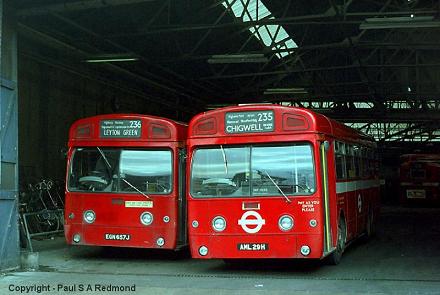
We were together as a crew until 16 April 1971, then the 236
went OMO with SMSs and we lost the 210s which went to Muswell Hill
(MH). The next day was a Sunday. I went back onto the 236 doing the
road on OMO with a few slight route changes. We did work together
as a crew now and again, sometimes when I did a rest day. The
236/210 was a fun road and I think that in some ways that I was
sorry that it all changed but we had a mortgage to pay so the extra
money was very useful.
The entrance to Leyton
Garage holds SMS657 from the 236 and early SMS21 on the 235, the
route that took over the section of the 236 between Leytonstone and
Leyton Hainault Road.
Photo © Paul Redmond
I have good memories of when being a busman was a proud job and
you were the best if you were on the Board.